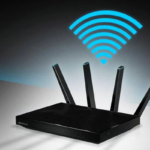In reality, setting up multiple WiFi modems sharing 1 network line is not common. Let’s find out why in the following article.
Understanding the correct terms
Before setting up multiple WiFi modems sharing 1 network line, you need to understand the correct terms, including modem, router, WiFi router, and WiFi modem.
Modem – short for Modulator and Demodulator, translates signals. The most common example we use today is fiber optic, where the modem translates light signals into digital signals (0 and 1) for electronic devices to understand.
/fptshop.com.vn/uploads/images/tin-tuc/165705/Originals/thiet-lap-nhieu-modem-wifi-dung-chung-1-line-nha-mang-7.jpg)
However, for a network line provided by an internet service provider, you would need to use multiple devices. The modem cannot know which packets are coming from or going to which device. This is where the router comes in. The router, also known as a Gateway, has the function of adjusting and directing the data packets. A router does not necessarily need to have WiFi.
Finally, the WiFi modem is the combination of a modem and a WiFi router into a single device – the device typically provided by the internet service provider. The easiest way to differentiate them is that a WiFi modem must be able to connect to the network line (typically fiber optic), while a WiFi router does not have this function.
Normally, when purchasing WiFi devices on the market, they are all WiFi routers. Most WiFi routers nowadays are designed to be “plug and play,” meaning you just plug them in and they work. Users can easily set them up through applications on their phones without much knowledge of networking. That’s why setting up multiple WiFi modems sharing 1 network line is not common.
But if you are really setting up multiple WiFi modems sharing 1 network line, for example, if you are reusing another WiFi modem to extend the coverage area, then we need to set up a few things to make it work.
How to set up multiple WiFi modems sharing 1 network line
General principle
When setting up multiple WiFi modems sharing 1 network line, one modem will connect to the network line (referred to as the primary modem or modem 1) and act as both a modem and a router. The remaining WiFi modems will only act as routers and no longer use the modem function.
/fptshop.com.vn/uploads/images/tin-tuc/165705/Originals/thiet-lap-nhieu-modem-wifi-dung-chung-1-line-nha-mang-9.jpg)
Now let’s introduce another term called DHCP – Dynamic Host Configuration Protocol. Simply put, DHCP is a protocol that helps the router assign IP addresses to end devices (phones, computers, etc.). For example, if the router’s IP address is 192.168.1.1, the devices connecting to the router will be assigned consecutive IP addresses like 192.168.1.2, 192.168.1.3, and so on.
By default, WiFi modems are assigned static IPs, usually 192.168.1.1 or 192.168.0.1. The problem arises when both modems have DHCP enabled and they have the same IP, which can lead to duplicate IPs and no internet connection.
There are two options you can choose, either option is acceptable:
Option 1: Enable DHCP on modem 1 and disable DHCP on secondary modems (modems 2, 3, 4, etc.). The IP addresses on the secondary modems must be the same as the primary modem’s IP address. Use a LAN cable to connect the LAN port of modem 1 to the LAN port of modems 2, 3, etc. It’s important to note that it should be LAN to LAN in order to work. In this option, modem 1 will assign IP addresses to all devices in the system, regardless of which modem they are connected to. Many people often make the mistake of plugging it into the WAN port of the secondary modem, which won’t work. This option is suitable if you have fewer devices (around 20-30 devices). Some routers like Viettel F670Y do not have a WAN port, so you have to use this option.
/fptshop.com.vn/uploads/images/tin-tuc/165705/Originals/thiet-lap-nhieu-modem-wifi-dung-chung-1-line-nha-mang-6.jpg)
Option 2: Enable DHCP on all modems, change the IP addresses on the secondary modems to avoid duplication with the primary modem and each other, use a LAN cable to connect the LAN port of modem 1 to the WAN port of modems 2, 3, etc. (LAN to WAN). In this option, each modem will assign IP addresses to the devices connected to it. If you have many devices, it is recommended to use this option to avoid overloading the main modem or running out of IP addresses.
Implementation steps
Each modem may have slightly different implementation steps, but here I will guide you through the primary modem, which is Viettel F670Y, and the secondary modem, which is an FPT modem.
Usually, there is no need to set up the primary modem, but here I will also guide you on accessing the DHCP Server on the Viettel modem:
Step 1: Connect your computer/phone to modem 1 using a cable or WiFi (usually, the WiFi name and password are printed on the back of the modem; if they have been changed, reset the modem before proceeding).
Step 2: Access the IP address of the modem, which is also printed on the back of the modem along with the login username and password.
Step 3: Log in to the modem (the password used to be admin, but now it is usually randomly set, and only the username is admin).
/fptshop.com.vn/uploads/images/tin-tuc/165705/Originals/thiet-lap-nhieu-modem-wifi-dung-chung-1-line-nha-mang-10.jpg)
Step 4: For the Viettel F670Y modem, click on Advanced Setup.
/fptshop.com.vn/uploads/images/tin-tuc/165705/Originals/thiet-lap-nhieu-modem-wifi-dung-chung-1-line-nha-mang-4.jpg)
Step 5: Click on Local Network > LAN > Find DHCP Server. Because this is the primary modem, make sure it is enabled. If it is already enabled, you don’t need to do anything else.
/fptshop.com.vn/uploads/images/tin-tuc/165705/Originals/thiet-lap-nhieu-modem-wifi-dung-chung-1-line-nha-mang-3.jpg)
Step 6: Next, disconnect from the primary modem and connect to the secondary modem (or use another computer/phone), follow steps 1-5 above. For FPT modems, you don’t need to perform step 4, the interface will display “Network” instead of “Local,” but in general, they are either one of these two options, and you can easily find where to set the DHCP Server.
/fptshop.com.vn/uploads/images/tin-tuc/165705/Originals/thiet-lap-nhieu-modem-wifi-dung-chung-1-line-nha-mang-5.jpg)
Step 7: If you choose Option 1, disable DHCP Server (on the secondary modem) and click save/apply. If you choose Option 2, enable DHCP Server but change the IP addresses to avoid duplication with the primary modem. For example, you can change it to 192.168.2.1, 192.168.3.1, and then click save/apply.
Tip: After logging in to a modem, make sure to set up the WiFi name, password, and other information if needed, to avoid having to do it later.
Step 8: Use a LAN cable to connect the primary modem and the secondary modems. If you choose Option 1, remember to use “LAN to LAN.” For Option 2, use “LAN to WAN.” At this step, there is a small tip for you. Many internet service provider modems, such as Viettel F670Y, only have one LAN port that supports Gigabit speed (1000Mbps), while the remaining ports are limited to 100Mbps. Therefore, always prioritize LAN 1.
Try connecting to the WiFi of each modem. If both can connect to the internet, then you have successfully set up multiple WiFi modems sharing 1 network line.
- How to fix phone unable to connect to WiFi issue
- What is Mesh WiFi? A compilation of the important benefits of Mesh WiFi in modern life

































